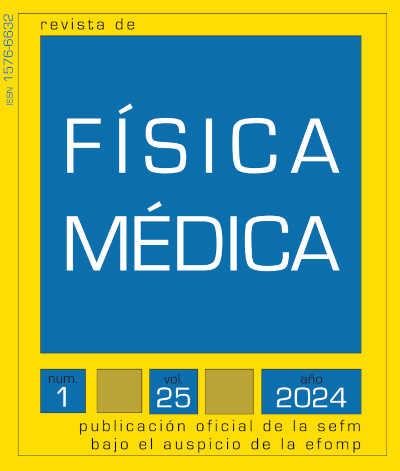Validación de imágenes generadas a partir de imágenes tomográficas de haz cónico usando redes neuronales de aprendizaje profundo para radioterapia adaptativa
DOI:
https://doi.org/10.37004/sefm/2024.25.1.003Palabras clave:
TC sintético, redes neuronales, U-NET, Radioterapia adaptativaResumen
Durante los tratamientos de Radioterapia, se adquieren imágenes tomográficas del paciente. Estas imágenes presentan artefactos que limitan su validez para el cálculo de dosis. Es posible, con el uso de redes neuronales, hacerlas más adecuadas para el cálculo de dosis. Empleamos la conocida red neuronal U-NET para entrenar un modelo capaz de generar imágenes tomográficas aptas para el cálculo de dosis. El modelo se entrena con imágenes de tórax de 25 pacientes. El resultado se verifica sobre las imágenes de 14 pacientes: 10 de tórax y 4 de pelvis. Con las Imágenes de CBCT se generan unas TC sintéticas que se comparan con las de simulación. Se evalúan el error medio (EM) error absoluto medio (EAM) la relación máxima de señal ruido (RMSR) y el índice de similitud estructural (ISE).
Se compara la dosis calculada sobre el TC con la calculada sobre ambos CBCT. Se calcula el índice gamma de similitud entre las matrices de dosis y los valores de D5, D95 y dosis media sobre el PTV.
Se observa una mejora estadísticamente significativa en todos los parámetros estudiados.
La red neuronal U-NET puede emplearse para modificar imágenes de CBCT y hacerlas más aptas para el cálculo de dosis.
Referencias
Naimuddin S, Hasegawa B, Mistretta CA. Scatter-glare correction using a convolution algorithm with variable weighting. Med Phys. 1987;14(3):330-334. https://doi.org/10.1118/1.596088
Xu Y, Bai T, Yan H, et al. A practical cone-beam CT scatter correction method with optimized Monte Carlo simulations for image-guided radiation therapy. Phys Med Biol. 2015;60(9):3567-3587. https://doi.org/10.1088/0031-9155/60/9/3567
Zollner, ¨ C., Rit, S., Kurz, C., Vilches-Freixas, G., Kamp, F., Dedes, G., Belka, C., Parodi, K., & Landry, G. Decomposing a prior-CT-based cone-beam CT projection correction algorithm into scatter and beam hardening components. Physics and Imaging in Radiation Oncology. 2017; 3, 49–52. https://doi.org/10.1016/j.phro.2017.09.002
Burgos N, Cardoso MJ, Thielemans K, et al. Attenuation correction synthesis for hybrid PET-MR scanners: application to brain studies. IEEE Trans Med Imaging. 2014;33(12):2332-2341. https://doi.org/10.1109/TMI.2014.2340135
Ye DH, Zikic D, Glocker B, Criminisi A, Konukoglu E. Modality propagation: coherent synthesis of subject-specific scans with data-driven regularization. Med Image Comput Comput Assist Interv. 2013;16(Pt 1):606-613. https://doi.org/10.1007/978-3-642-40811-3_76
Kapanen M, Collan J, Beule A, Seppälä T, Saarilahti K, Tenhunen M. Commissioning of MRI-only based treatment planning procedure for external beam radiotherapy of prostate. Magn Reson Med. 2013;70(1):127-135. https://doi.org/10.1002/mrm.24459
Cao X, Yang J, Gao Y, Guo Y, Wu G, Shen D. Dual-core steered non-rigid registration for multi-modal images via bi-directional image synthesis. Med Image Anal. 2017;41:18-31. https://doi.org/10.1016/j.media.2017.05.004
Huynh T, Gao Y, Kang J, et al. Estimating CT Image From MRI Data Using Structured Random Forest and Auto-Context Model. IEEE Trans Med Imaging. 2016;35(1):174-183. https://doi.org/10.1109/TMI.2015.2461533
Eckl M, Hoppen L, Sarria GR, et al. Evaluation of a cycle-generative adversarial network-based cone-beam CT to synthetic CT conversion algorithm for adaptive radiation therapy. Phys Med. 2020;80:308-316. https://doi.org/10.1016/j.ejmp.2020.11.007
Maspero M, Houweling AC, Savenije MHF, et al. A single neural network for cone-beam computed tomography-based radiotherapy of head-and-neck, lung and breast cancer. Phys Imaging Radiat Oncol. 2020;14:24-31. Published 2020 May 25. https://doi.org/10.1016/j.phro.2020.04.002
Liang X, Chen L, Nguyen D, et al. Generating synthesized computed tomography (CT) from cone-beam computed tomography (CBCT) using CycleGAN for adaptive radiation therapy. Phys Med Biol. 2019;64(12):125002. Published 2019 Jun 10. https://doi.org/10.1088/1361-6560/ab22f9
Ronneberger, O., Fischer, P., Brox, T. U-Net: Convolutional Networks for Biomedical Image Segmentation. In: Navab, N., Hornegger, J., Wells, W., Frangi, A. (eds) Medical Image Computing and Computer-Assisted Intervention – MICCAI 2015. MICCAI 2015. Lecture Notes in Computer Science(), vol 9351. Springer, Cham. https://doi.org/10.1007/978-3-319-24574-4_28.
Radiuk P. Applying 3D U-Net Architecture to the Task of Multi-Organ Segmentation in Computed Tomography. Applied Computer Systems. 2020;25(1): 43-50. https://doi.org/10.2478/acss-2020-0005
Vesal, S., Ravikumar, N., Maier, A. A 2D dilated residual U-Net for multi-organ segmentation in thoracic CT. arXiv preprint arXiv:1905.07710, 2019.
Xuetao Wang, Wanwei Jian, Bailin Zhang, Lin Zhu, Qiang He, Huaizhi Jin, Geng Yang, Chunya Cai, Haoyu Meng, Xiang Tan, Fei Li, Zhenhui Dai. Synthetic CT generation from cone-beam CT using deep-learning for breast adaptive radiotherapy. Journal of Radiation Research and Applied Sciences. 2022; 15(1):275-282. https://doi.org/10.1016/j.jrras.2022.03.009.
Zhou Wang, A. C. Bovik, H. R. Sheikh and E. P. Simoncelli. Image quality assessment: from error visibility to structural similarity. IEEE Transactions on Image Processing, 2002; 13(4): 600-612. https://doi.org/10.1109/TIP.2003.819861.
Low DA, Harms WB, Mutic S, Purdy JA. A technique for the quantitative evaluation of dose distributions. Med Phys. 1998;25(5):656-661. https://doi.org/10.1118/1.598248








